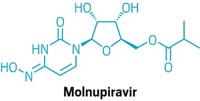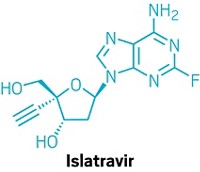Advertisement
Grab your lab coat. Let's get started
Welcome!
Welcome!
Create an account below to get 6 C&EN articles per month, receive newsletters and more - all free.
It seems this is your first time logging in online. Please enter the following information to continue.
As an ACS member you automatically get access to this site. All we need is few more details to create your reading experience.
Not you? Sign in with a different account.
Not you? Sign in with a different account.
ERROR 1
ERROR 1
ERROR 2
ERROR 2
ERROR 2
ERROR 2
ERROR 2
Password and Confirm password must match.
If you have an ACS member number, please enter it here so we can link this account to your membership. (optional)
ERROR 2
ACS values your privacy. By submitting your information, you are gaining access to C&EN and subscribing to our weekly newsletter. We use the information you provide to make your reading experience better, and we will never sell your data to third party members.
Materials
Conquering HIV’s capsid
After a dozen years, researchers have struck upon a molecule that can disrupt an elusive HIV target
by Lisa M. Jarvis
July 31, 2017
| A version of this story appeared in
Volume 95, Issue 31

For most of his career at Gilead Sciences, medicinal chemist Winston Tse has lived and breathed one thing. While his peers at other companies hopped from project to project, Tse has spent the past decade obsessing over a single target: the HIV capsid.
HIV’s capsid is a complex, protein-rich shell that protects the genetic payload the virus is trying to sneak into the cells of its host. Tse’s goal? To prove that a small molecule can disrupt that shield and keep the virus from replicating.
Getting to his goal has taken tenacity. For perspective, Tse’s daughter was born the year he started working on capsid inhibitors; this fall, she’ll be in the fourth grade.
Finally, Tse and a sizable team of medicinal chemists, biologists, virologists, and academic partners have done it. By 2018, Gilead expects to begin human studies of a capsid inhibitor with the potential to be dosed once a month or less frequently. It will be the first time a capsid inhibitor makes it to the clinic.
Sweet success, but tempered by the knowledge of how good the drug needs to be. Tse’s daughter isn’t the only thing to have changed since the chemist first set to work in the lab. HIV treatments have dramatically improved in that time, to the point where the majority of people with the virus are well served by existing pills, many made by Gilead. To compete, Gilead’s molecule will need to be as safe and effective as current treatments and substantially more convenient.
An elusive target
From the mid-1990s to the mid-2000s, chemists made great progress on drugs that inhibit HIV, mainly by blocking viral enzymes. But the virus has a tricky way of developing work-arounds to treatments, requiring researchers to constantly invent new and better molecules and molecule combinations.
In the hunt for new targets to combat resistance, HIV’s capsid seems like a strong candidate. Aside from its obvious appeal as a vital shield for the viral genome, the capsid offers a potential solution to the resistance problem that plagues HIV treatment.
The region of the viral genome that encodes for the capsid protein is among its most unchanged stretches, explains Vanderbilt University virologist Christopher Aiken. Because much of the recipe for the capsid protein has remained constant over the ages, a drug that targets it will likely evade resistance longer.
But when Gilead began the project, not much was known about the capsid, which is made up of 1,500 capsid proteins that organize themselves into hexamers and pentamers to form an eggplant-shaped shell. HIV researchers had no close-ups of the full capsid; a crystal structure had captured only the monomeric protein.
Moreover, scientists weren’t—and still aren’t—sure how the capsid assembles. Many envision something like a molecular knitting project that begins at the stem end of the eggplant and gets wider as rows of hexamers are added.
Yet one thing was clear: Those 1,500 proteins need to knit together with just the right geometry and kinetics. “There is a real beauty in how geometrically structured it is,” says Tomas Cihlar, vice president of biology at Gilead.
The shell needs to be stable enough to come together during virus maturation but still disassemble to expose its genetic payload once it is inside the host cell. That leads to a “delicate equilibrium in the whole capsid shell, which we thought could really be its Achilles’ heel,” Cihlar, who conceived of the capsid program back in 2006, adds.
In addition to having limited structural information about the shell, Gilead researchers knew of no molecules that could convincingly bind to the capsid protein. The only clues in the literature were “some really bad, reactive small molecules with very low potency,” Cihlar recalls. “Ultimately, we ended up questioning the selectivity of those compounds.”
Gilead’s own high-throughput-screening efforts did not yield any promising hits. When Tse and another medicinal chemist joined the project in 2008 to design molecules, they were essentially staring at a blank canvas.
Even worse, they weren’t trying to block an individual protein, like most small-molecule drugs are designed to do; rather, they wanted to find a compound that could wedge between adjacent capsid proteins in the pinwheel-like hexamers that assemble into the larger shell. “It’s hard to imagine de novo how you’re going to disrupt this process,” Tse says.
The Gilead medicinal chemists began with a modest goal: Show that a small molecule bound to adjacent capsids would block—even weakly—the replication of the virus. The problem was so tough and expectations so low that Tse’s boss told him that if they could demonstrate even submicromolar activity (most drugs have nanomolar potency), “we should declare victory and walk away,” he recalls.
Then, in 2009, a breakthrough: Academic researchers published a crystal structure of the capsid hexamer, giving chemists their first glimpse at how the protein units interact.
A year later, Pfizer published the crystal structure of a capsid inhibitor convincingly bound to the capsid. But the potency of its compound was modest, and Pfizer didn’t put a drug into the clinic.
Progress, at last
The Pfizer compound “changed our chemistry approach quite considerably,” Cihlar recalls. With this starting point, Gilead’s medicinal chemists quickly came up with a promising scaffold. Then came the hard part: improving the potency and stability of the molecule. Its initial compounds were almost instantly chewed up in the liver.
It took Tse’s team another six years, during which they made some 4,000 molecules, to get to an actual drug candidate. During that time, the molecule grew as the chemists tried to devise something that could span the sizable interface between two capsid proteins in the hexamer.
“We definitely used all the tricks we had in our tool kit,” Tse says, pointing out that its capsid inhibitors are bristling with fluorines. “I firmly believe that every single atom that’s on that molecule is important.”
During the years Tse spent optimizing the capsid inhibitor, detractors emerged within the company. “We used a lot of our rope,” he says, grinning. At one point, a senior manager told research leadership that it would be impossible to combine all the needed properties into a single molecule. He reminded Tse that his team had asked for “six more months” to work on the problem several times.
A week after that tense exchange, Tse was able to show the manager data proving that his team had designed the elusive molecule.
The most prominent feature of Gilead’s capsid inhibitor is its picomolar-range potency. Cihlar recalls that when he first saw the potency data, he thought, “Okay, this is something special. None of the other HIV drugs even come close to the potency of the compound.”
Gilead has yet to unveil data on the molecule it will put into the clinic. But at an infectious disease conference in February, Tse presented preclinical proof-of-concept data on its capsid inhibitor program using a tool compound, GS-CA1. The chemical probe can block replication at two stages in the virus life cycle. It prevents the capsid from properly assembling by, he hypothesizes, speeding up how fast the components of the shell draw together. The compound is also active after a viral particle makes it inside the host cell, interfering with capsid disassembly and the delivery of genetic material.
Although Gilead had impressive potency data, there was a problem: Its lead capsid inhibitor has the solubility of a rock. That meant it would have to be administered as an injection, normally a nonstarter given how many good daily HIV pills are available.
Moreover, in the 12 years since Gilead launched its capsid inhibitor program, HIV treatments have dramatically improved. In no small part due to once-daily medicines developed by Gilead, most people are well served by existing HIV therapies. Andrew Cheng, Gilead’s executive vice president of clinical R&D operations, puts it bluntly: “It’s not 1996 anymore.”
The next wave
Those advances have upped the ante for new HIV treatments. With comparable safety and efficacy a given, new drugs need to offer a functional cure or at least be significantly more convenient.
“The next big step will be intermittent therapy,” says Pablo Tebas, director of the AIDS clinical trial unit at the University of Pennsylvania. It’s hard to remember to take a pill each day, and psychologically, that pill is a daily reminder of one’s HIV status. A treatment that people take monthly, or even less frequently, could improve compliance. A long-acting drug could also make sense for those taking antivirals to prevent HIV infection in the first place.
Most people who have HIV and are engaged in their care are well served by their regimens of one to two pills per day, says Paul Edward Sax, clinical director of the division of infectious diseases at Brigham & Women’s Hospital.
But, Sax adds, many people living with HIV “wish for something that frees them from having to take pills every day. So there is patient interest, even among those doing well.” Sax consults with, or is on the scientific advisory board of, multiple pharmaceutical companies, including Gilead.
In other words, by the time Gilead researchers arrived at a stable, potent compound, poor solubility was not necessarily an issue because it was a prime candidate to become an injected long-acting therapy. “Without a doubt, we were never thinking about a long-acting drug,” Tse acknowledges.
At the February meeting, Gilead unveiled data in rats showing its tool compound GS-CA1 is active for as long as 10 weeks. Gilead researchers are now working to formulate a subcutaneous injection of its drug candidate that could be dosed once a month or even quarterly.
UPenn’s Tebas cautions that a lot can happen between data in cells or rats and trials in humans. Moreover, Gilead isn’t the only firm working on a long-acting drug.
Last fall, ViiV Healthcare, an HIV-focused company that is majority owned by GlaxoSmithKline, launched a Phase III study of a once-monthly injectable treatment. The ViiV therapy combines a new integrase inhibitor, cabotegravir, with an approved nonnucleoside reverse transcriptase inhibitor, rilpivirine. Last week, ViiV shared results from a midphase study showing the viral load was better controlled among people taking the long-acting treatment than for those taking oral antivirals. ViiV is also studying whether cabotegravir given once every two months could prevent new HIV infections.
Cihlar acknowledges that ViiV’s two drugs have a significant lead. But both require an intramuscular injection, which could mean a monthly trip to the doctor, of a fairly sizable amount of drug, he notes. “We certainly want to go beyond that—less frequent and easier to administer,” he says. “Maybe the reasonable ambitious target would be once every three months.”
Gilead is now determining the appropriate drug, if any, to pair with its lead molecule and expects to start a clinical trial next year. It will be the first time an HIV capsid inhibitor is tested in humans.
Tse says he’ll be nervous, but gratified, when the first patient is dosed with his drug. After all, the most recent novel HIV treatment, an integrase inhibitor, was approved more than 10 years ago. “New mechanisms in HIV don’t happen very often,” he says.







Join the conversation
Contact the reporter
Submit a Letter to the Editor for publication
Engage with us on Twitter